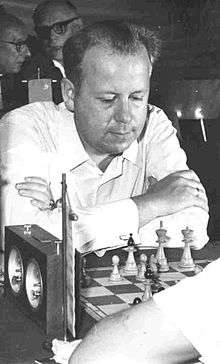Wolfgang Uhlmann
Wolfgang Uhlmann (born 29 March 1935) is a prominent German chess grandmaster. He was East Germany's most successful professional chess player.
| Wolfgang Uhlmann | |
|---|---|
 Uhlmann in 1967 | |
| Full name | Wolfgang Uhlmann |
| Country | Germany |
| Born | 29 March 1935 Germany |
| Title | Grandmaster |
| Peak rating | 2575 (January 1978) |
Chess career
Uhlmann's father taught him the game at the age of 11 at their home in Dresden and he progressed to the title of German Youth Champion in 1951. He learned the trade of letterpress printing[1], but his career in chess prevented him from practicing it. By 1956 he was an International Master, and by 1959 a Grandmaster.
He quickly established himself as the dominant force in East German chess, winning the German Democratic Republic (GDR) national championship 11 times from 1954 to 1986. He was the GDR's most outstanding player at the Chess Olympiads of 1956–1990, where he made 11 appearances, mostly on top board. At the 1964 event in Tel Aviv, he scored 83.3 percent, earning him the individual board one gold medal. An individual bronze medal followed in 1966 at Havana.

His most successful attempt at World Championship qualification occurred at the Palma de Mallorca Interzonal of 1970, where he tied for fifth and sixth place and reached the Candidates Matches the following year. But his quarter-final match with Bent Larsen in Las Palmas ended in disappointment, a 5½–3½ victory for Larsen, and Uhlmann was not able to come so close again.
During the 1960s, Uhlmann performed well in international tournaments. He shared victory (with Lev Polugaevsky) at Sarajevo 1964, tied for first (with Vasily Smyslov) at Havana 1964, tied for first (with Borislav Ivkov, and ahead of World Champion Tigran Petrosian) at Zagreb 1965, tied for first (with Boris Spassky) at Hastings 1965/66, tied for first (with David Bronstein) at Szombathely 1966, tied for first (with Vladimir Liberzon) at Zinnowitz 1967 and tied for first with Bronstein at the Berlin 'Lasker Memorial' in 1968. At Raach in 1969, a zonal tournament, he finished two points clear of a field which included Lajos Portisch.
He also enjoyed some success in the 1970s and 1980s. He tied for first with Bronstein and Vlastimil Hort at Hastings 1975/76, placed second behind Anatoly Karpov at Skopje 1976, finished first at Vrbas 1977, tied for first with Farago and Rainer Knaak at Halle 1978, and was an outright winner at Halle 1981.
In 2012, age 77, Uhlmann was a member of the "Old Hands" group of senior previous top players who played the "Snowdrops", a group of talented young females, in a display match. The game Kashlinskaya–Uhlmann was considered the most beautiful of the event, with Uhlmann's play recalling the young Mikhail Tal.[2]
Legacy
Uhlmann is acknowledged as one of the world's leading experts on the French Defence, having refined and improved many of its variations and written books on the opening. He is one of very few grandmasters to have deployed the French almost exclusively in reply to 1.e4.
Example games
| a | b | c | d | e | f | g | h | ||
| 8 |  | 8 | |||||||
| 7 | 7 | ||||||||
| 6 | 6 | ||||||||
| 5 | 5 | ||||||||
| 4 | 4 | ||||||||
| 3 | 3 | ||||||||
| 2 | 2 | ||||||||
| 1 | 1 | ||||||||
| a | b | c | d | e | f | g | h | ||
Bronstein vs. Uhlmann, Tallinn 1977
1. e4 e6 2. d4 d5 3. Nc3 Bb4 4. e5 Ne7 5. a3 Bxc3+ 6. bxc3[3] c5 7. Qg4 Qc7 8. Qxg7 Rg8 9. Qxh7 cxd4 10. Ne2 Nbc6 11. f4 Bd7 12. Qd3 dxc3 13. h4 0-0-0 14. h5 Nf5 15. h6 Rg6 16. h7 Rh8 17. Rh3 (17.Rb1 f6 18.exf6 Be8 19.Qxc3 Rxh7 20.Rxh7 Qxh7 21.Rb3 [Vasiukov–Doroskevic, USSR 1967] d4!=/+ Ivkov[4]) d4! 18. Rb1 Be8 19. Qf3 Qd8+/− 20. g4 Nh4 21. Qh1 Rxg4 22. Ng3 Rxh7 23. Ne4 (see diagram; "Black now sacrifices a piece to establish a fatal pin on the long light-square diagonal."[5]) Nxe5 24. fxe5 Bc6 25. Bd3 Kc7 26. Kf2 Rh5 27. Rf3 Qg8 28. Bf4 Nxf3 29. Qxh5 Rxf4 30. Qh6 Ng5+ 0–1[6]
References
- https://www.mz-web.de/mitteldeutschland/wolfgang-uhlmann-wird-80-ddr-schach-genie-gewann-gegen-fuenf-weltmeister-897444
- http://www.chessbase.com/newsdetail.asp?newsid=8713
- French Defence, Winawer Variation (ECO C18)
- Matanović, Aleksandar, ed. (1981). Encyclopaedia of Chess Openings. C (2nd ed.). Yugoslavia: Chess Informant. p. 111, n. 100.
- Hooper & Whyld (1987), p. 366
- David Bronstein vs. Wolfgang Uhlmann, It (cat. 10) (1977) Chessgames.com
Bibliography
- OlimpBase – The History of the Chess Olympiads
- Hooper, David; Whyld, Kenneth (1987). The Oxford Companion to Chess. Oxford University Press. ISBN 0-19-281986-0.
External links
- Wolfgang Uhlmann player profile and games at Chessgames.com